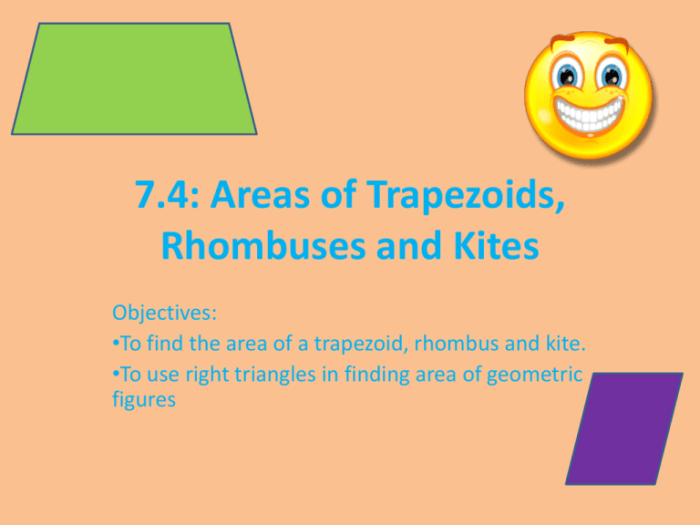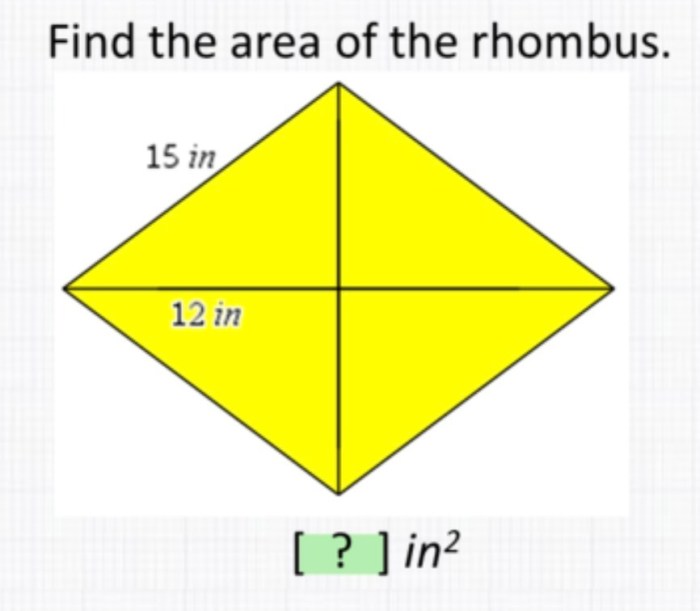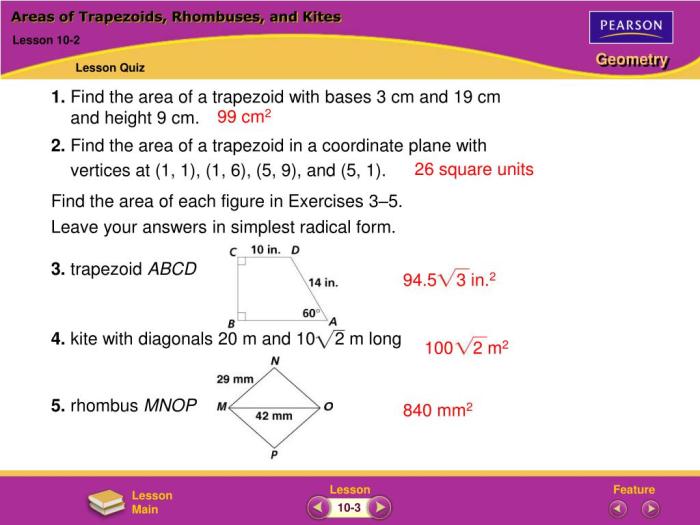Areas of trapezoids rhombuses and kites answers – Embark on a mathematical journey as we delve into the fascinating world of trapezoids, rhombuses, and kites, unlocking the secrets to calculating their areas. This comprehensive guide will provide a clear understanding of the formulas, properties, and relationships that govern these intriguing shapes, empowering you to solve real-world problems with precision.
From the humble trapezoid to the elegant rhombus and the graceful kite, each shape holds unique characteristics that determine its area. We will explore the connections between their dimensions, unraveling the intricate relationships that make these shapes so captivating.
Areas of Trapezoids
A trapezoid is a quadrilateral with two parallel sides. The formula for finding the area of a trapezoid is:
Area = (1/2) – (base1 + base2) – height
Where:
- base1 and base2 are the lengths of the parallel sides
- height is the distance between the parallel sides
For example, if a trapezoid has parallel sides of length 10 cm and 15 cm, and a height of 8 cm, its area would be:
Area = (1/2) – (10 cm + 15 cm) – 8 cm
Area = (1/2) – (25 cm) – 8 cm
Area = 100 cm 2
The height, bases, and area of a trapezoid are related by the following equation:
Area = (1/2) – (base1 + base2) – height
Areas of Rhombuses: Areas Of Trapezoids Rhombuses And Kites Answers

A rhombus is a parallelogram with four equal sides. The formula for finding the area of a rhombus is:
Area = (1/2) – diagonal1 – diagonal2
Where:
- diagonal1 and diagonal2 are the lengths of the diagonals
The following table compares the formulas for the area of a square, rectangle, and rhombus:
| Shape | Formula |
|---|---|
| Square | Area = side2 |
| Rectangle | Area = length
|
| Rhombus | Area = (1/2)
|
Rhombuses are unique among parallelograms because they have four equal sides and two pairs of opposite angles that are equal.
Areas of Kites

A kite is a quadrilateral with two pairs of adjacent sides that are equal. The formula for finding the area of a kite is:
Area = (1/2) – diagonal1 – diagonal2
Where:
- diagonal1 and diagonal2 are the lengths of the diagonals
To calculate the area of a kite given its diagonals, follow these steps:
- Multiply the length of the first diagonal by the length of the second diagonal.
- Divide the product by 2.
For example, if a kite has diagonals of length 10 cm and 15 cm, its area would be:
Area = (1/2) – 10 cm – 15 cm
Area = (1/2) – 150 cm 2
Area = 75 cm 2
The diagonals and the area of a kite are related by the following equation:
Area = (1/2) – diagonal1 – diagonal2
Comparative Analysis

The following table compares the formulas for the area of trapezoids, rhombuses, and kites:
| Shape | Formula |
|---|---|
| Trapezoid | Area = (1/2)
|
| Rhombus | Area = (1/2)
|
| Kite | Area = (1/2)
|
The formulas for the area of trapezoids, rhombuses, and kites are all similar in that they involve multiplying two lengths and dividing the product by 2. However, the specific lengths that are multiplied differ for each shape.
The formulas for the area of trapezoids, rhombuses, and kites can be used to solve real-world problems involving these shapes. For example, the formula for the area of a trapezoid can be used to find the area of a triangular flower bed, and the formula for the area of a rhombus can be used to find the area of a diamond-shaped window.
Expert Answers
What is the formula for finding the area of a trapezoid?
The area of a trapezoid is calculated using the formula: Area = 1/2 – (base1 + base2) – height, where base1 and base2 represent the lengths of the parallel bases, and height represents the perpendicular distance between the bases.
How do I calculate the area of a rhombus?
The area of a rhombus is calculated using the formula: Area = 1/2 – diagonal1 – diagonal2, where diagonal1 and diagonal2 represent the lengths of the rhombus’s diagonals.
What is the relationship between the diagonals and the area of a kite?
The area of a kite is calculated using the formula: Area = 1/2 – diagonal1 – diagonal2, where diagonal1 and diagonal2 represent the lengths of the kite’s diagonals. The diagonals of a kite are perpendicular to each other, forming four right triangles within the kite.
